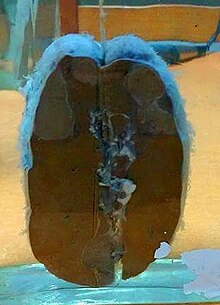Splenic infarction
| Splenic infarction | |
|---|---|
 | |
| Splenic infarct seen on CT | |
| Specialty | General surgery |
Splenic infarction is a condition in which blood flow supply to the
In one series of 59 patients, mortality amounted to 5%.
Diagnosis
Although it can occur
An abdominal CT scan is the most commonly used modality to confirm the diagnosis,[3] although abdominal ultrasound can also contribute.[5][6][7]
Treatment
There is no specific treatment, except treating the underlying disorder and providing adequate
Causes


Several factors may increase the
In some conditions, blood clots form in one part of the circulatory system and then dislodge and travel to another part of the body, which could include the spleen. These
Splenic infarction is also more common in hematological disorders with associated
Any factor that directly compromises the splenic artery can cause infarction. Examples include abdominal traumas,
Splenic infarction can be due to vasculitis or disseminated intravascular coagulation. Various other conditions have been associated with splenic infarction in case reports, for example granulomatosis with polyangiitis[15] or treatment with medications that predispose to vasospasm or blood clot formation, such as vasoconstrictors used to treat esophageal varices, sumatriptan[16] or bevacizumab.[17]
In a single-center retrospective cases review, people who were admitted to the hospital with a confirmed diagnosis of acute splenic infarction,
Therapeutic infarction
Splenic infarction can be induced for the treatment of such conditions as
References
- PMID 28613652, retrieved 2019-02-27
- PMID 3764696.
- ^ PMID 9486895.
- PMID 8371303.
- S2CID 31332720.
- PMID 3773568.
- PMID 8997756.
- PMID 18510036.
- S2CID 36770769.
- PMID 29158925.
- PMID 15550267.
- PMID 18171204.
- S2CID 2702794.
- PMID 18684317.
- PMID 26817911.
- PMID 16767537.
- PMID 17138227.
- ^ PMID 26356690.
- PMID 15761342.
